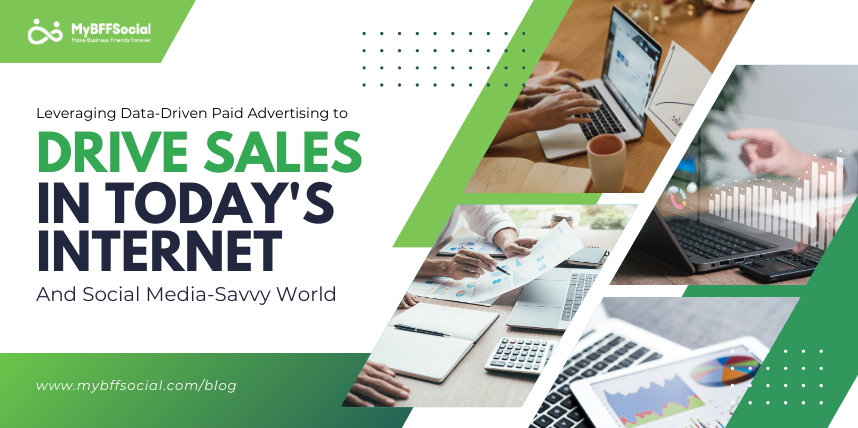
In the contemporary digital landscape, businesses have unprecedented access to data that can drive marketing strategies and boost sales. Paid advertising, a cornerstone of modern marketing, has evolved significantly with the advent of advanced data analytics. The ability to harness and interpret vast amounts of data allows companies to create targeted, efficient, and impactful advertising campaigns. This blog explores how the data-driven nature of paid advertising can enhance sales for businesses in today’s internet and social media-savvy world.
The Power of Data-Driven Advertising
Data-driven advertising involves using insights derived from data analysis to inform and optimize marketing strategies. This approach contrasts with traditional advertising, which often relies on broad, generic campaigns with limited targeting capabilities. The key advantages of data-driven advertising include precision targeting, real-time optimization, and improved ROI.
- Precision Targeting
Data-driven advertising allows businesses to precisely target their audience based on various parameters such as demographics, interests, behaviors, and purchase history. Social media platforms like Facebook, Instagram, and LinkedIn, as well as search engines like Google, offer sophisticated targeting options that enable advertisers to reach specific segments of the population.
- Demographic Targeting: Businesses can tailor their ads to specific age groups, genders, income levels, and other demographic factors. This ensures that the right message reaches the right audience, increasing the likelihood of conversion.
- Behavioral Targeting: By analyzing users’ online behavior, such as websites visited, products viewed, and interactions with content, businesses can create highly relevant ads that resonate with potential customers.
- Geographic Targeting: Ads can be targeted to users in specific locations, allowing businesses to focus their efforts on regions where they have a presence or where their products and services are in high demand.
- Real-Time Optimization
One of the most significant advantages of data-driven advertising is the ability to optimize campaigns in real-time. With access to real-time data, marketers can monitor ad performance and make adjustments on the fly to improve effectiveness.
- Performance Metrics: Metrics such as click-through rates (CTR), conversion rates, and cost per acquisition (CPA) provide insights into how well an ad is performing. If an ad is underperforming, adjustments can be made to the targeting, creative, or bidding strategy to enhance results.
- A/B Testing: Businesses can run multiple versions of an ad simultaneously to see which one performs better. This process, known as A/B testing, allows for data-driven decisions on which ad creative, headline, or call-to-action (CTA) to use.
- Budget Allocation: Real-time data allows marketers to allocate budgets more effectively. By identifying high-performing ads and channels, businesses can invest more in what works and reduce spend on underperforming areas.
- Enhanced Customer Insights
Data-driven advertising provides valuable insights into customer preferences, behaviors, and buying patterns. This information can be used to create more personalized and relevant advertising campaigns.
- Customer Segmentation: By segmenting customers based on their data, businesses can tailor their messaging to different groups. For example, new customers might receive introductory offers, while loyal customers could be targeted with exclusive rewards or upsell opportunities.
- Personalization: Personalization increases engagement and conversion rates. Data allows for dynamic ad creation, where the content of an ad can change based on who is viewing it. For instance, an ad for a clothing store can show different products to users based on their past browsing history.
- Improved ROI
The ultimate goal of any advertising campaign is to drive sales and achieve a positive return on investment (ROI). Data-driven advertising helps businesses achieve this by ensuring that their ad spend is used efficiently and effectively.
- Cost Efficiency: By targeting ads more precisely and optimizing them in real-time, businesses can reduce wasted ad spend. This ensures that the advertising budget is used to reach the most relevant and high-potential customers.
- Higher Conversion Rates: Targeted and personalized ads are more likely to convert viewers into customers. By focusing on high-intent users, businesses can increase their conversion rates and drive more sales.
- Long-Term Value: Data-driven advertising helps build stronger relationships with customers by providing them with relevant and engaging content. This not only drives immediate sales but also contributes to long-term customer loyalty and lifetime value.
Case Study: Success through Data-Driven Advertising
Consider a hypothetical online retail company that sells home décor. By leveraging data-driven advertising, the company can achieve significant growth in sales:
- Targeting: The company uses demographic data to target young professionals and newlyweds, who are likely to be in the market for home décor. Behavioral data is used to identify users who have recently searched for home improvement ideas.
- Personalization: Ads are personalized based on users’ browsing history. Someone who viewed sofas on the company’s website will see ads featuring discounts on sofas, while another user who looked at wall art will see ads showcasing the latest art pieces.
- Real-Time Optimization: The company monitors ad performance in real-time, adjusting bids and creatives based on which ads are driving the most conversions. Underperforming ads are quickly paused, and budget is reallocated to high-performing ones.
- Results: By focusing on data-driven strategies, the company sees a significant increase in CTR and conversion rates. The precise targeting and personalization efforts lead to a 30% increase in sales, while the optimized ad spend results in a 25% reduction in CPA.
Conclusion
In today’s internet and social media-savvy world, data-driven paid advertising is a powerful tool that can drive substantial sales growth for businesses. By leveraging data to inform targeting, optimize in real-time, and personalize ads, businesses can achieve higher engagement, better conversion rates, and improved ROI. As the digital landscape continues to evolve, those who embrace data-driven advertising will be well-positioned to outperform their competition and achieve sustained success.
Ready to harness the power of data-driven paid advertising for your business? Contact BFF Social today to discover how we can help you drive sales and achieve your marketing goals through advanced data analytics and targeted advertising strategies. Our team of experts is here to guide you every step of the way.
